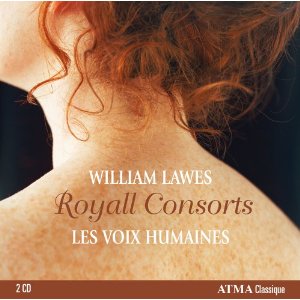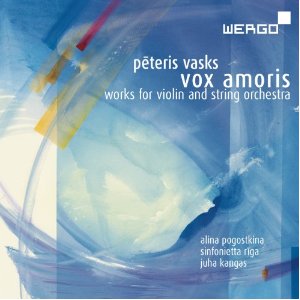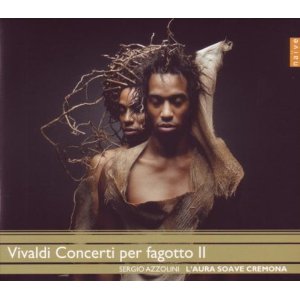|
You are reading the older HTML site
Positive Feedback ISSUE 61
Notes of an Amateur: Lawes, Vasks, Vivaldi.
William Lawes, Royal Consorts, Les Voix Humaine. Atma Classique. ACD2 2373. Not too far along the way from the sonorous ebb, flow, and harmonic weightiness of renaissance music to the busy and intricately counterpointed works of the baroque fall Monteverdi, Schutz, Purcell, and William Lawes. They are closer to the spirit of the sixteenth century than to the seventeenth, but we can hear, especially in Lawes, a reaching for more complex expression and sophistication. Lawes' Royal Consorts played by the wonderful Canadian ensemble Les Voix Humaines (gambists Susie Napper and Margaret Little and four friends on baroque violins and therobes—large lutes) give great pleasure. Napper and Little are the definitive performers of Sainte Columbe, reviewed here a year or so, and are also fine interpreters of Purcell. They play with sensitivity, lightness, and restraint, enabling Lawes to speak with ease and grace; in contrast with Jordi Savall and friends, who wring more overt emotion from this music and Phantasm who play it with more vigor. Canadian musicians often seem to be a special breed who, by laying back a little produce performances that wear extremely well. Much of this music breathes the spirit of dance. Even the slow sections have a rhythmic swing to them that can turn into something approaching whispered melancholy. I could go on but I'd rather listen to this album again.
Péteris Vasks, Vox Amores. Works for Violin and String Orchestra. Alina Pogostkina, violin. Sinfonietta Riga. Juha Kangas, conductor. Wergo WER 0750-2. Assignment to composer: make a violin come out of the dark, slip into the world almost invisibly, and then swell into almost unbearable beauty. Make it keen with sorrow and loss but make the keening so beautiful that the beauty is equal to the pain. This is the formula for music by contemporary Latvian composer Péteris Vasks—actually for a great deal of the most moving Eastern European and Russian music composed in the late twentieth and early twenty-first centuries. It stares directly into the face of the modernist avant-garde music of its time and challenges its cool aestheticism. These three works were written between 1990 and 2009, and while the description above refers specifically to Vox Amores (2008/2009) which opens the album, it really applies to all three. Unlike a great deal of contemporary classical music, it finds meaning in human responses to darkness, pain, and sorrow rather than in various forms of aesthetic accommodation. It is emotionally bold, assertive, insistent. Distant Light (1996-1997), Vasks' famous concerto for violin and orchestra, is the main work here. It has been recorded many times, most recently by Anthony Marwood for Hyperion. https://positive-feedback.com/Issue61/amateur.htm It seems that it is impossible to play this work badly. Pogostkina and Kangas play it a little slower than I'm used to, to great effect. This is a modern masterwork which gains power with the space they give it. Pogistkina, born in St. Petersburg, educated in and adopted by Germany, plays with the great emotional expressiveness the work demands, and the Lativian ensemble, Sinfonietta Riga, is all we could ask for. I sometimes think that Vasks is the phoenix that the Soviet repression of its 'conquered' people created. This is a wonderful album. Sound is up to the usual very high Wergo standards. Where would we be without the likes of such labels?
Vivaldi, Concerti per Fagotto (bassoon) II. Sergio Azzolini, bassoon, L'Aura Soave Cremona. Diego Cantallupi, director. Vivaldi Edition, Volume 48. naïve OP 30518. Vivaldi is the only composer I know who has been able to teach the barking bassoon to sing—and actually, very few others have tried. Thanks in no small part to soloist Sergio Azzolini, who returns to reprise his spirited performance in No. I of the composer's concertos for the instrument, we are getting to hear a generous portion of the thirty-nine that Vivaldi wrote in what has to be definitive form. What is most striking about this music is hearing how expressive an instrument generally used for color and effect can be when asked to be the principal voice. Vivaldi makes the bassoon sing, meditate, dance, play, croon, and even speak (!) The cello, another of the composer's favorite instruments, is often considered the most human of instrumental voices; but here the bassoon seems even more so. Sometimes accompanied by strings, it is primarily as unaccompanied soloist that the alleged duck truly becomes a swan. It turns out that our 'problem' with the bassoon, as with the viola, is mainly our problem. Neither of these instruments has a conventionally beautiful voice—it has its own, deeply imbued with character that a brilliant musician can bring out. Azzolini is a marvel. The more time we spend with him and Vivaldi, the more natural and moving these concertos become. Equipment used for this audition: Resolution Audio Cantata CD player; Crimson CS710 solid state preamplifier & CDS 640E solid state monoblock amplifier; Jean Marie Reynaud Orféos Supreme loudspeakers; Crimson cables. Bob Neill, in addition to being an occasional equipment and regular music reviewer for Positive- Feedback Online, is also proprietor of Amherst Audio in Amherst, Massachusetts, which sells equipment from Audio Note, Blue Circle, JM Reynaud, and Crimson Audio.
|



